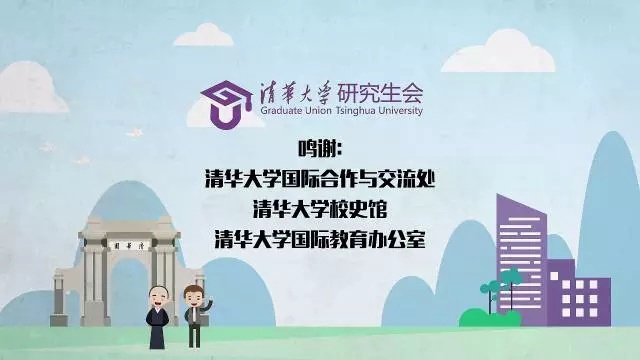Tsinghua University has been taking large footsteps towards internationalization ever since its establishment, here is what the students from the Graduate Union has to say about this ongoing trend.
Tsinghua's Internationalization in 4 Minutes by Liang Lianfen and Huang Yulei, Graduate Union
With mist-shrouded mountains lying to the west
And boundless swaths of the sea to the east
Our school is solemnly
Taking the center of the world
西山苍苍,东海茫茫,吾校庄严,世界中央
......
Well, it is by no means the correct lyrics of our school anthem.

But Tsinghua University, located in the Wudaokou Area or ‘Center of the Universe’ (as the locals affectionately call), should be empowered with international glamor, to take firm root in the central spot.
Click to watch the video on Tencent

Let’s wind the clock backward to 1909,
when the U.S.A. established a pre-course school for American study for the Chinese with China’s Boxer Indemnity,
It was one of the predecessors of Tsinghua University,
School for the American Study.

Featuring a typical American style in terms of its education system,
it was then regarded as the ‘most international’ school.
17 foreign teachers were recruited among the first batch of enrolled teachers.

Steel wire beds
with furnaces installed in the dorms,
Showers and flush toilets could also be found in the bathrooms.
Students at Tsinghua could experience life in the West in advance
before pursuing study abroad.

Although the ‘American style’ dominated the international style of Tsinghua,
self-improvement and national salvation were priorities for Tsinghua students.
A myriad of talented Tsinghua students returned home from their academic course in the US,
and formed the mainstay of all parts of society in China.

After the arduous War of Resistance against Japanese Aggression and the Liberation War,
New China was founded!
International development in Tsinghua ushered in the new chapter for ‘Modelling on the Soviet Union’.

The scholastic year system supplanted the credit system;
Russian replaced English;
Textbooks of Soviet Union were translated in plenty;
Pundits from the Soviet Union were recruited;
Students were prepped to enroll in Soviet Union schools.
All aimed at the Soviet Union.

The Main Building was built in 1966,
and bears resemblance to Soviet architectural styles, which always reminds us of the past.

With support from the Ministry of Education, Tsinghua also welcomed its first batch of ‘overseas students’ in New China.
33 overseas students from 5 Eastern European countries
made astounding progress in Chinese
with the help of a talented teaching team at Tsinghua.

The famous Chinese physicist Zhou Peiyuan once served as their class supervisor, and was especially nominated by the Central Government.

Each foreign student enjoyed a food subsidy of 250 kilograms of millet per month
with a combination of Western and Chinese food selections.
It seems that eating well is a historic tradition in Tsinghua,
which enjoys its fame throughout the globe.

Back then, the ‘Soviet Union Style’ is the international style Tsinghua students tried to follow,
during which time Tsinghua groomed a cohort of patriotic intellectuals.
and was known as the cradle for ‘Red Engineers’.

With the United States
and the Soviet Union as its role model,
Tsinghua does not slow down its cause to create a more internationalized environment.
The world is vast,
and we want to look around.

In 1977, with the advent of
the Reform and Opening-up of China,
Tsinghua positioned its development on the spacious international stage.
In the 1990s,
Tsinghua spared no efforts to develop itself as a ‘World-class University’.
and it has been making progress by leaps and bounds in the cause of internationalization.

By 2015,
Tsinghua had cultivated over 30,000 overseas students
and now has 14 Master’s degrees programs taught in English.
Well-known overseas teachers and a join-cultivation culture help further the internationalization of Tsinghua.
Around 1/3 of students would have a chance to go abroad for academic exchange.

Asian Youth Exchange Center will help assign you a foreign roommate,
which gives you a first-hand experience of globalization.

Not enough?
Following its centennial anniversary, Tsinghua launched three programs for internationalization,
Schwarzman Scholars, a program for groundbreaking cross-cultural global leadership,
Tsinghua has also obtained support from Microsoft and partnered with University of Washington to establish the Global Innovation Exchange and the Tsinghua-Berkeley Shenzhen Institute,
which will boost the global competence of Tsinghua students.

Now, let’s take a look at its performance on the international stage.
In the 2016 QS Ranking for World Colleges,
Tsinghua ascended to the 24th place,
leading all other domestic universities and colleges.
In US News World College Ranking for 2015,
Engineering subjects of Tsinghua outranked MIT and seized first place.
We will continue our efforts.

2016 marked the first year when Tsinghua used simultaneous interpretation at its opening ceremony for all the students.
According to President Qiu Yong,
a more internationalized Tsinghua would provide you a broader stage,
and set free your passions and dreams

Now, as a student at Tsinghua,
why don’t you start with a little goal?
Like becoming the next Nobel Laureate,
or the Chinese counterpart of Henry Kissinger,
or even someone like Mark Zuckerberg who speaks Chinese!

The genes of internationalization have been passed down in Tsinghua for over a century,
and in the new era,
Tsinghua sets its eye on the global stage,
Tsinghua students are defining their own styles to be more international.
A week ago, Tsinghua launched its online international student hub, XiaoyanOnline
Extract the QR code to define THUer's Internationalization yourselves!

清华国际范儿 U-sight U define!

Contributor: International Department, Graduate Union of Tsinghua University
Writer: Liang Lianfen, Huang Yulei
Editor: Xiaobo